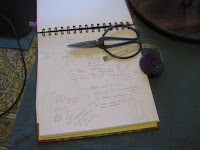This last fall during an Arts & Sciences evening, Baroness Katya asked me to make her a heraldic sideless surcoat. Now you may have noticed that this is the first appliqué project on my blog. There's a reason for that! I promised to step outside my comfort zone and do my best.
Of course, I didn't plan on breaking my foot before the deadline, so the best laid plans of mice became a little eschew. I still managed to complete it - and take on a new office - but I really should have allowed myself more time to rest and heal. She was great and understanding, but unfortunately I listened not to the sweet voice of reason, but to my own stubborn nature... and it kicked me in the tail again!
But on to the project!
This image is titled "Isabella before the Virgin and Child" and marked 1417-1418. She wanted something along the lines of this style, but without the ermine and using the heraldry of the
Barony of the Steppes. She also asked me to - if at all possible - keep two parts of the device easily removable (the tree and the laurel wreath), so she could still wear the garment when she eventually steps down from office.
This was the initial plan, with a green top, black bottom, and a gold stepped sash across the body. The silver (oops!) wreath at top right and the Steppes' Oak on bottom left. I was supposed to do the trunk, roots, and branches of the tree and she would embroider the acorns later on.
I've seen some pretty poorly fitting sideless surcoats before, so I decided that my first task would be to shop for a pattern that I thought would be flattering, true to the form, and be something I'd enjoy trying out on my own project later on. I finally settled on Burda 7977.
Since I knew the sash was going to be a consistent element (and not removed later on), I went ahead and made it structural. For the life of me I couldn't convince it to lie straight and still leave room for the laurel wreath, so I allowed it to swoop just a little bit in order to get the full effect.
Tailor's chalk was totally my friend here, and it allowed me to measure like twenty times before the first cut.
I zig-zagged the edges to prevent any kind of raveling (it *really* wanted to ravel on me) and then pressed down the smallest seam allowance I could.
After that, I used cotton jean thread (perfect color match, and cotton!) to sew down all the actual steps.
Once the steps were in place, the tailor's chalk came to the rescue again, and I was able to cut off the black fabric overlap while still maintain my seam allowance.
A quick zip back through the machine and the two pieces were combined. To match the steps on the other side, I went over the bottom of the sash in the same manner.
And here you have the combined front piece. There are some bits that need a little more cleaning up, but that will come soon!
Detail of the stitching behind the sash.
I have to admit, I was on some pretty nice painkillers for the broken foot while I was working on this section. I didn't realize that the laurel wreath was supposed to be silver instead of gold. Unfortunately, the baroness had to remove it and replace it with the correct color. But hey, we tried out the ease of removal and that feature seems to have worked fine!
And here's a detail of the (so I thought!) completed laurel wreath. I've learned more now about linen appliqué, but I'm not in a hurry to use it!
Detail of the (supposedly!) completed front, with top-stitching along the edges to maintain shape. I did fully line this sideless surcoat, so it has an excellent swish factor! It had been so long since I'd done a project like this that had forgotten some pretty salient points about making things lie flat. Baste, baste, baste! Cut to match! Luckily those were relatively minor things and easily corrected.
And the tree! It turned out a little smaller and higher than I'd like, and that's mostly due to the way I had to work on it while my foot was in the cast. On the ironing board (my working surface), it looked perfect, but there was no way for me to fully lay it out and look at it full scale. I've already made the offer to re-do it now that my foot has healed, but she seems happy with it, and that was the whole goal.
Besides, it may be a little tree, but it's a cute one, too!
This is what I thought would be the final image of the dress. I do again sincerely apologize about the color mix-up. I'm blaming it on the pain meds!
Finally, we have one more shot of Baroness Katya wearing it at court during Steppes Warlord, with the matching underdress that she made herself. Lovely!
































